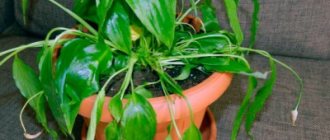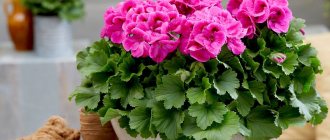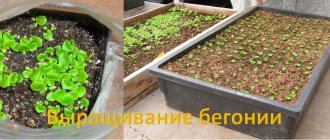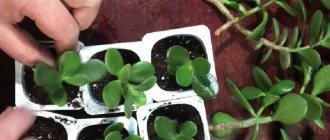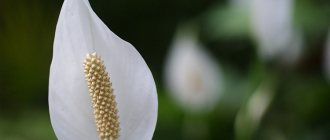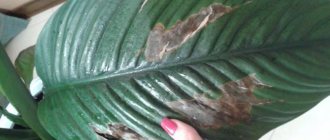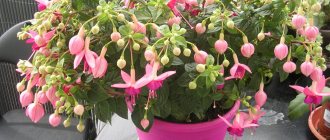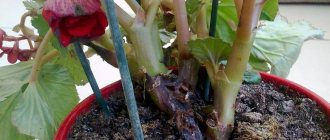What is this problem?
A dry state is a sign of leaf dieback. A harbinger of this phenomenon is a change in the color of the leaf plate, when, as a result of unfavorable factors or natural aging, the flower stops producing chlorophyll. As a result, it is colored in the color of auxiliary pigments, mainly yellow.
If the leaf is dry, then it cannot perform its direct functions:
- photosynthesis;
- gas exchange;
- transpiration.
The structure of the sheet plate becomes brittle, crumbles easily, and cracks may appear. Over time, such a leaf falls off.
Lighting
Like any tropical plant, it cannot grow well without good lighting. Therefore, the container with it must be placed in a well-lit place, but not in direct sunlight, which can cause burns on its foliage and flowers.
The best place for it would be a place with soft, diffused light. If the room is too dark, then it is recommended to install artificial lighting above the flower, which is turned on in the morning and turned off at night so that it can rest. If it is impossible to hide an exotic flower from direct sunlight, simply cover it with paper.
Photo
This is what a drying plant looks like:
Why does the flower of Women's Happiness turn yellow and dry out?
A similar phenomenon occurs as a result of a natural process or due to a change in the general condition of the plant. The death of the leaf is directly related to the poor functioning of the root system, which is not able to fully provide the spathiphyllum with nutrients and moisture. Causes of exotic malaise:
- Lighting. An incorrectly selected location, for example a window sill on the south side, can dry out the leaf blade of the flower. The hot rays of the sun provoke yellowing, spots, so-called thermal burns.
- Humidity. Spathiphyllum requires high humidity. Dry air leads to condensation of moisture from the green surface of the leaves, which provokes rapid drying. This parameter can be created manually with a spray bottle of water or using a household humidifier.
- Temperature. Indoor exotic should be in a warm room, but away from heating radiators and drafts. Sudden temperature changes are an extremely negative phenomenon for leaves, especially for delicate flowers.
- Big pot. The roots of a plant planted in an unsuitable container cannot fully fill the entire space. Therefore, stagnation of water occurs, alkalization of the substrate, formation of harmful gases, development of pathogenic microflora, as a result of which the rhizome rots.
- Unsuitable soil. Spathiphyllum prefers loose, slightly acidic soil enriched with minerals. When purchasing a ready-made substrate, you can add a little natural leavening agent, but it’s better to have less peat.
- Incorrect watering regime. The death of the root system is often caused by uneven moisture.
Important! Overdrying the soil or flooding is quite dangerous for the roots. Spathiphyllum prefers moist, but not wet soil and moderate watering. - Lack of nutrients. This phenomenon is possible if indoor exotic plants have not been replanted for a long time. Depleted the soil. Or during the care process no fertilizing is applied at all, as a result the plant experiences a kind of “starvation”. This condition can be easily corrected by adding complex mineral fertilizers to the regime.
Causes of leaf tips drying out, how to eliminate them
Spathiphyllum domino flower - home care
There are frequent requests to specialists: “Spathiphyllum care at home, why do the tips of the leaves dry out?” The reasons may be the following:
- Not enough moisture. First, the foliage begins to quickly lighten and turn yellow, then it also quickly dries. Dry air is very destructive for the flower, because it comes from a tropical marine climate. To compensate for the lack of moisture, the leaves are wiped of dust and sprayed with a spray bottle. You can also place the pot on a tray, which is covered with a drainage mixture (sand, pebbles, expanded clay) and filled with water.
- Too much moisture. Oddly enough, but for this reason the tips of the leaves also dry out. The housewife, believing that the flower needs abundant watering, can provoke stagnation by excessive moisture. As a result, the roots cannot cope and begin to rot and the leaves dry out. It would be better to put a layer of moss moistened with water in a pot or take a double container. The flower is placed in a large container, and wet peat is placed in the space between the two containers.
- Incorrect feeding. Most likely, the plant lacks minerals. It is worth adding nitrogen, potassium and phosphorus to the soil.
- Bad place for a flower. Check whether the flower is standing in the scorching sun or, on the contrary, is overcooled.
The ends of the leaves have dried out
Consequences
The first sign of future leaf dryness is dry ends. In the future, if no measures are taken, the leaves may dry out completely and fall off. If the cause of this process is aging, then it’s okay. A new young shoot will appear in this place.
It’s bad when very young shoots dry out. This is a serious reason for decisive action. With complete passivity, you can lose the plant. Drying of the roots entails the drying out of the green mass, subsequently the death of the exotic.
What to do if they dry out?
Leaves
If a plant's leaves dry out, the reason most likely lies in lighting, incorrect composition of the soil mixture, temperature, or insufficient watering. Let's consider a set of measures to eliminate such a nuisance.
- Provide your indoor flower with a well-lit place to live.
- In summer, shade bright rays with a tulle curtain.
- If possible, move the pot to a window on the east or west side.
- The room should be warm.
- In winter, cover heating appliances with a damp terry towel.
- Avoid drafts.
- Do not expose the plant to the cold.
- In case of irregular watering or frequent drying out of the soil, the flower and pot are dipped into a container of water.
- Leave to recharge for half an hour.
- You can spray the green mass with a warm shower.
- In the future, control watering.
Foliage tips
This symptom is directly related to dry indoor air, as well as lack of nutrition. In this case, you should take action.
Apply complex mineral fertilizers.
- Use no more than once every 7-10 days.
- Follow the instructions for using fertilizers indicated on the packaging.
- It is preferable to use drugs in liquid form.
- Spray moisture from a spray bottle every day.
- Place a tray with wet sand, expanded clay, and pebbles.
- Wash the leaves with soapy water at least once a week.
- Use a household humidifier.
- Provide regular warm showers for green foliage.
Flowers
Spathiphyllum really prefers moist soil, but sometimes owners will not be able to find the correct moisture limit. As a result, the soil becomes oversaturated with water. In this case, problems arise with the roots, which are constantly in the wet substrate, and the process of rotting develops.
Reference. A healthy root system is vital for flowers. The deterioration of the roots is correspondingly reflected in the leaves and flowers, which in turn turn yellow and dry out.
To correct this type of error you should:
- Remove the plant from the pot and inspect the roots.
- Rinse them with warm water.
- Use a sharp knife to remove rotten, dead roots.
- Trim yellow shoots.
- Disinfect the sections with ground cinnamon.
- Leave to dry for a while.
- Transplant the flower into new dry soil, with a mandatory drainage layer.
- There is no need to water immediately after transplanting.
- Maintain control over the frequency of watering.
Find out more nuances about what spathiphyllum drying out is, why it happens and what to do to save the flower in this material.
Spathiphyllum: leaves turn black around the edges, what to do
Why do the tips of dracaena leaves dry out - what to do
The sources of development of non-standard appearance include a number of factors. Botanists advise first understanding the reason for the blackening of the leaf blades and only then taking up the resuscitation of the affected specimen.
Why do the tips of all the leaves of Spathiphyllum turn black and how to save it:
- freezing of the root system. The tropical flower prefers to grow at temperatures not lower than 15-18 °C. The pot needs to be moved closer to the heat source, not forgetting about regular spraying;
- incorrectly selected soil. Spathiphyllum needs loose, easily permeable soil. A dense and compacted substrate causes moisture stagnation, provoking the development of rot in the root system. The consequence of decay is blackness on the green part;
- low air humidity. In the first weeks, yellowing and drying of the foliage are observed, and a little later it turns black. The exotic plant requires watering and spraying throughout the calendar year. Spathiphyllum will perceive a break as a drought and will begin to get rid of excess leaves;
Spathiphyllum leaves turn black
- excess fertilizer. Excess nutrients are no less destructive than their deficiency. To resolve the issue, you need to take a break of one and a half months, and then adhere to the dosages indicated by the manufacturer on the nutrition label;
- waterlogging. Occurs when the number of waterings is incorrectly calculated. In summer, the procedure is performed every 3-4 days, in winter - less often. Before watering, you need to make sure that the top layer in the pot is dry enough;
- sunburn. Prolonged exposure to the sun leads to serious damage to the leaves of spathiphyllum. The affected parts must be removed and the container moved to partial shade until complete recovery.
Important! Immediately after acquiring a new specimen for the collection, you should not feed it. At least one and a half months are given for the adaptation of spathiphyllum. When selling, plants are planted in nutritious soil; it retains its properties throughout the specified period.
How to take care for prevention?
Regardless of the reason for dry sheets, general hygiene measures should be followed to avoid such problems.
To prevent the risk of soil contamination and eliminate salt deposits, periodically clean off the white deposits from the soil surface; the top layer can be replaced with new soil.
- Be sure to wash off the dust from the leaves and water the plant with a warm shower.
- Inspect for pests.
- For irrigation, use clean, settled, soft water without impurities, preferably at room temperature.
- Control the amount of water poured into the pot.
- Place the plant in a bright place. In summer, it is better to choose partial shade, or shade the bright rays.
- In winter, keep away from heating appliances.
- Feed exotics periodically with complex mineral fertilizers all year round.
Further care at home
In the future, adhere to all of the above measures, as well as:
- Maintain the temperature in the room where the spathiphyllum is +22-25°C.
- In winter, temperatures should not be allowed below +15°C.
- It is important that when ventilating, the flower does not get cold air.
- Indoor exotic prefers a higher humidity of 50-60%.
- Spray 2-3 times every day.
- Don't forget about comprehensive nutrition.
- Before flowering, it is better to use preparations with a high content of magnesium, phosphorus and potassium.
It is better to eliminate minimal errors in care and return the plant to its former healthy appearance than to take emergency measures to bring it back to life. If you notice small changes, then first of all pay attention to the growing parameters. Review the care instructions. Don't leave everything to chance.
If you find an error, please select a piece of text and press Ctrl+Enter.
Cause of leaf curling, how to fix it
It happens that the leaves of the spathiphyllum begin to shrink, and the remaining foliage curls into tubes. The plant signals that it urgently needs care and a change in watering, nutrition, and lighting regimes.
Leaf curling
The reasons for this process are:
- Low air temperature. In addition to the fact that the foliage becomes too dark, burgundy-green, it also seems to be trying to “warm up” by wrapping itself in a kind of cocoon. Perhaps the pot is on a windowsill where there are drafts or direct exposure to fan flow.
- Lack of sunlight. This often happens during winter cold or with constant rainfall. You can save the plant by installing a special lamp with ultraviolet radiation.
- Flower damage by aphids. The entire plant is urgently treated with the modern drug Actellik, which is effective after the first exposure to the pest.
Additional Information. It should be taken into account that indoor species of spathiphyllum have a predisposition to leaf curling. However, this process is not constant. Usually the leaves straighten out on their own soon.

